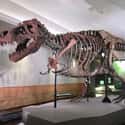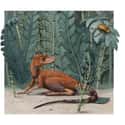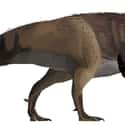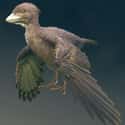-
(#4) The T. Rex Had A Major Growth Spurt As A Teenager
A study released in Science Advances magazine January 1, 2020, alleges the T. rex grew into its full size during adolescence, rendering the existence of the Nanotyrannus, or pygmy tyrannosaur, invalid. Scientists have previously proposed a smaller T. rex lived alongside the giant predators after examining two tyrannosaur skeletons from the Cretaceous period with a similar body structure. The new research, which used osteohistology (the study of bones) to analyze the same samples, studied their growth curves to identify their age, revealing they were "immature individuals 13 to 15 years of age, exhibiting growth rates similar to extant birds and mammals, and that annual growth was dependent on resource abundance."
Paleontologist Steve Brusatte, who reviewed the study, said most scientists are unfamiliar with the growth rates of the T. rex aside from the fact that they "had to grow fast to go from... hatching" out of an egg to approximately 19,000 pounds. Because the two fossils examined by researchers previously thought to be an entirely new species of pygmy dinosaurs are actually adolescent in age, it is likely the T. rex began to grow more rapidly during its teenage years depending on the available food sources.
-
(#1) Dinosaurs Might Have Evolved From A 4-Inch-Tall Reptile
In an article published in the journal Proceedings of the National Academy of Sciences on July 6, 2020, researchers described a newly discovered ancestor to giant dinosaurs and flying pterosaurs dug up in Madagascar. The Kongonaphon kely is approximately 4 inches tall and 237 million years old.
The lead author on the study, Christian Kammerer, mused the Kongonaphon kely "would probably make a great pet." Its name means "tiny bug slayer," a reference to the idea that it would jump around on its hind legs catching bugs all day.
Examining a section of the thigh bone allowed researchers to conclude the fossil is that of an adult.
-
(#11) Most Dinosaurs Had Feathers
Books and educational materials traditionally depicted dinosaurs as giant lizards. However, this is beginning to change as their evolutionary connection to birds is becoming increasingly apparent. The idea of a dino with plumage is difficult to imagine, but the majority of paleontologists now agree most - if not all - dinosaurs had feathers.
The discovery didn't happen all at once, but in stages, as researchers discovered more feathered specimens, and the truth became impossible to ignore. Since feathers don't usually preserve well, it took years before scientists discovered enough fossils to support the hypothesis. At first, only flesh-eating dinosaurs purportedly had feathers, but the discovery of a well-preserved, feathered herbivore species in 2014 compelled paleontologists to consider perhaps all dinosaurs were downy.
-

(#3) The Reaper Of Death Is The First New Tyrannosaur Discovered In Canada In 50 Years
Introducing the first new species of tyrannosaur discovered in Canada in 50 years. Meet Thanatotheristes degrootorum, the ‘reaper of death’! Read all about it on our blog: https://t.co/hIQZkxdACk #Thanatotheristes #ReaperOfDeath #RTMPResearch pic.twitter.com/WYNmsMuUFY
— Royal Tyrrell Museum of Palaeontology (@RoyalTyrrell) February 10, 2020Researchers with the University of Calgary and the Royal Tyrrell Museum revealed what they claim to be the first new tyrannosaur species discovered in Canada in 50 years, called the Thanatotheristes degrootorum - which combines the Greek translation for "reaper of death" with the name of the couple who found the fossils, the DeGroots. Jared Voris, a PhD student, found the skull fragments at the Royal Tyrrell Museum, and he concluded they did not match any known species of tyrannosaur, in part because of unique "vertical ridges along the upper jaw line."
The fragments Voris discovered were found near the Bow River by in 2010. Voris' thesis advisor, Darla Zelenitsky, said the new species predates the T. rex by 12 million years, and is therefore the "oldest known tyrannosaur discovered in Canada."
This Thanatotheristes appears to be its own distinct species, rather than an ancestor to the T. rex, and Voris speculates it could have been "8 meters long with an 80-centimeter skull."
-
(#20) Instead Of Roaring, Dinosaurs Probably Honked Like Ducks And Geese
The image of the Tyrannosaurus rex letting out a mighty, bellowing roar is one of the most memorable scenes from the Jurassic Park series - but it's also something a real T. rex wouldn't do. Dinosaurs would have had a syrinx like birds, not a larynx like mammals, and thus would have been incapable of producing a roar.
A 2016 study of a preserved voice box from a duck-like bird ancestor provided paleontologists with a good idea of what sounds dinosaurs could have produced, which include clicks, hisses, and honks similar to that of modern ducks and geese.
-
(#5) A Well-Preserved Fossil Provides New Information About The Evolution Between Dinosaurs And Modern Birds
Paleontologist Takuya Imai and colleagues discovered the well-preserved fossil of an Early Cretaceous bird in Japan in 2013. The skeleton, called the Fukuipteryx prima, or F. prima, is the first modern bird recorded outside northeastern China, according to a study published in Nature in November 2019. The study further suggests finding a modern bird skeleton outside China "increases our understanding about the complex morphological evolution in early birds with the presence of particularly primitive features in young individuals," given the animal's assumed age of about 1 year.
Imai told Smithsonian magazine researchers "were not expecting to find such good material from a fossil bird." Similar fossils discovered in China were often squished and incomplete, whereas this one was three-dimensionally preserved. And though the F. prima skeleton is assumed to be nearly 120 million years old, it looks similar to birds that evolved 30 million years earlier in the Jurassic period.
One of the most important features of the F. prima fossil might be its tailbone, also seen seen in birds today and thought to be a marker of birds' evolution from dinosaurs.
New Random Displays Display All By Ranking
About This Tool
The earth is about 4.6 billion years old. Dinosaurs lived on this mysterious and huge blue planet about 150 million years ago, and humans appeared about 6 million years ago. Unfortunately, dinosaurs were extinct during the Cretaceous period. For centuries, biologists have different opinions on the reasons for the extinction of dinosaurs, the most convincing theory is that an asteroid impact caused the disappearance of dinosaurs.
Over the years, dinosaur fossils of different periods and types have been discovered, which provide the most powerful evidence for historical research and biological evolution research, and humans can continue to explore the mysteries of dinosaurs. You could know 23 crazy facts about dinosaurs in this random tool.
Our data comes from Ranker, If you want to participate in the ranking of items displayed on this page, please click here.














